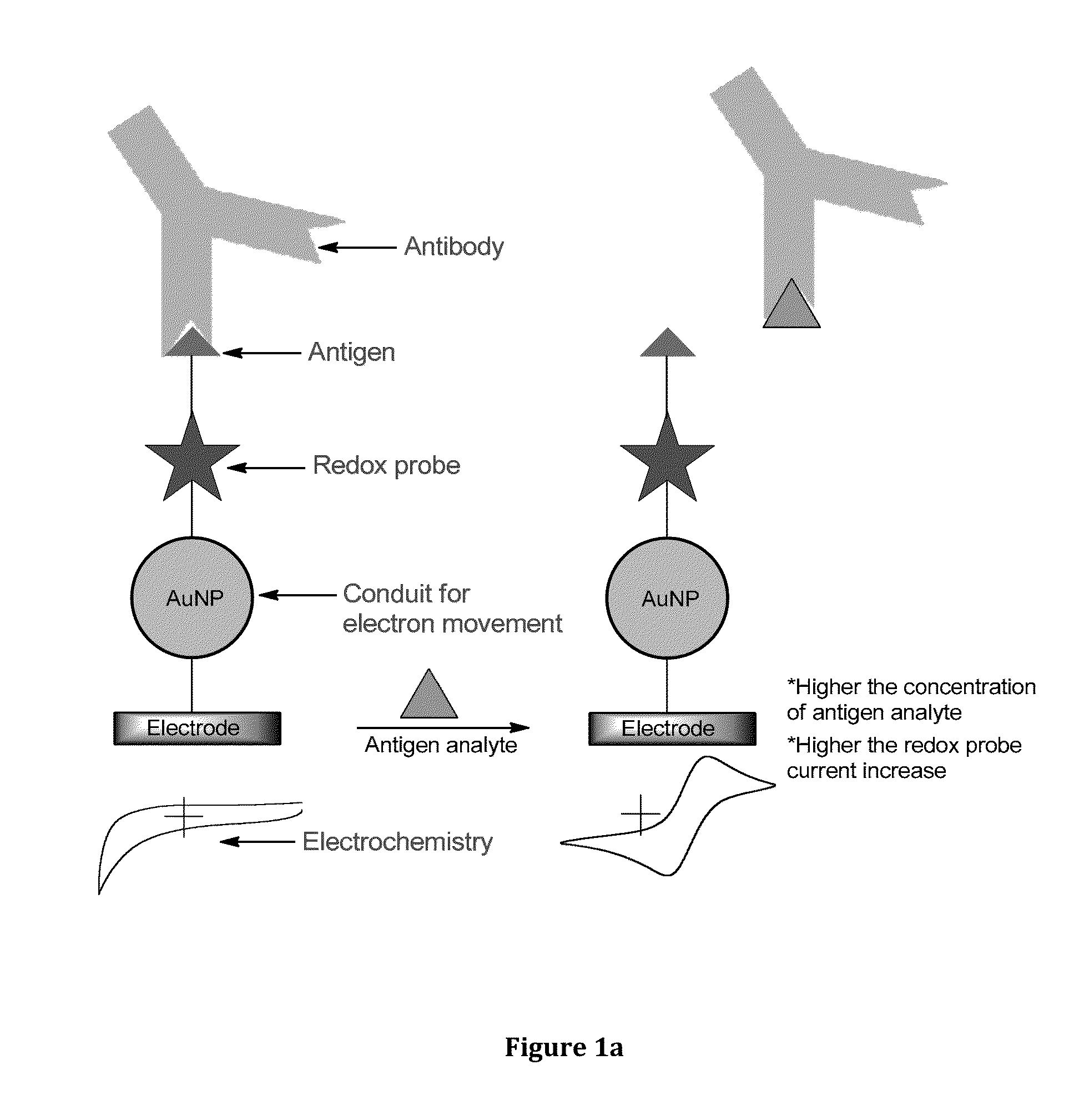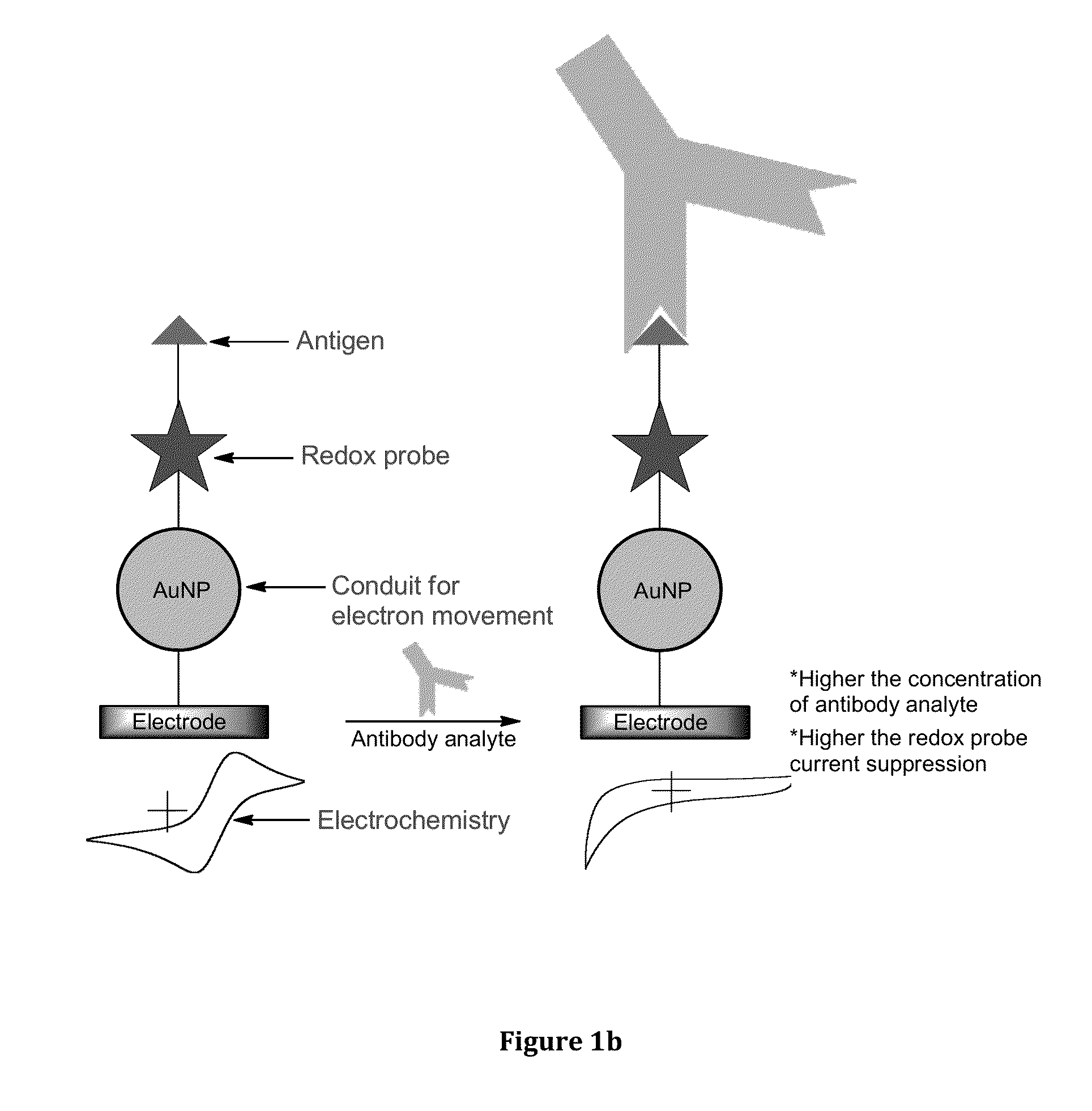Electrochemical affinity sensor
a technology of electrochemical and affinity sensor, which is applied in the field of electrochemical sensors, can solve the problems of difficult synthesis in large quantities, unstable air in air for sensors including molecular wires or carbon nanotubes, and difficult assembly of sensors with carbon nanotubes, etc., and achieve the effect of simplifying the detection process
- Summary
- Abstract
- Description
- Claims
- Application Information
AI Technical Summary
Benefits of technology
Problems solved by technology
Method used
Image
Examples
example 1
Fabrication of the Amperometric Immunosensor Based on Gold Nanoparticle-Diazonium Salt Modified Sensing Interface
[0117]The schematic of fabrication of the amperometric immunosensor for the detection of HbA1c is shown in FIG. 2. GC electrodes were first modified with 4-aminophenyl (GC-Ph-NH2), and then the terminal amine groups were converted to diazonium groups by incubating the GC-Ph-NH2 interface in NaNO2 and HCl solution to form a 4-phenyl diazonium chloride modified interface (GC-Ph-N2+Cl−). Subsequently gold nanoparticles (AuNP) were immobilized on the interface by electrochemical reduction and the formation of a stable C—Au bond to achieve a 4-phenyl AuNP modified interface (GC-Ph-AuNP). Then, the GC-Ph-AuNP modified surface was incubated in absolute ethanol solution containing 10 mM OEG and 40 mM DCC for 6 h at room temperature to form the OEG modified GC surfaces (GC-Ph-AuNP / OEG).
[0118]Subsequently, surface attached AuNP was further functionalized with 4-carboxyphenyl by sca...
example 2
Electrochemistry of the Amperometric Immunosensor Based on AuNP-Diazonium Salt Modified Sensing Interface
[0119]After the attachment of GPP to the sensor of Example 1, the electrochemistry of FDMA modified GC electrode surfaces showed only minor change in peak currents indicating the peptide does not block the surface electrochemistry, a necessary condition for the sensor to be able to operate. However, as can be seen in FIG. 4, complexation of anti-HbA1c IgG with the GC-Ph-AuNP / OEG / 4-CP / FDMA / GPP results in an obvious attenuation of the ferrocene electrochemistry (b). Current attenuation suggests changes in the interfacial microenvironment arising from formation of an immunocomplex on the electrode surface. Formation of the complex is hypothesized to restrict counterion access to the ferrocene probe with a corresponding decrease in current.
[0120]Non-specific adsorption is a key issue for a label-free immunosensor. In order to check if there is any non-specific binding to the GPP term...
PUM
| Property | Measurement | Unit |
|---|---|---|
| Diameter | aaaaa | aaaaa |
| Diameter | aaaaa | aaaaa |
| Time | aaaaa | aaaaa |
Abstract
Description
Claims
Application Information
 Login to View More
Login to View More - R&D
- Intellectual Property
- Life Sciences
- Materials
- Tech Scout
- Unparalleled Data Quality
- Higher Quality Content
- 60% Fewer Hallucinations
Browse by: Latest US Patents, China's latest patents, Technical Efficacy Thesaurus, Application Domain, Technology Topic, Popular Technical Reports.
© 2025 PatSnap. All rights reserved.Legal|Privacy policy|Modern Slavery Act Transparency Statement|Sitemap|About US| Contact US: help@patsnap.com



